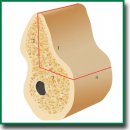
Modified Two-Stage Split Technique for Controlled Ridge Augmentation in Horizontally Atrophic Posterior Mandible: the First Stage of Research
Various bone grafting methods are applied to eliminate horizontal atrophy of the jaws. However, problem complexity brings about ongoing research and development of new ways to achieve the predicted stable and long-term results of implantological treatment.
The aim of the study was to evaluate the results of the developed method for bone grafting, a modified two-stage split technique for controlled ridge augmentation in horizontally atrophic posterior mandible, using radiological analysis data.
Materials and Methods. The study group included 18 patients with horizontally atrophic posterior mandible. According to cone beam computed tomography, 39 jaw segments were assessed before plastic surgery and after applying the two-stage split-crest technique for controlled ridge augmentation. The alveolar ridge width was estimated in the area of its top and at a distance of 1, 3, 5 mm from it using the vector of future implant position and taking into account the angle of inclination of the atrophic region of the mandible.
Results. When analyzing edentulous areas in the posterior mandible before treatment, there was rather a large angle of lingual inclination of the alveolar ridge. After 6 months, the average increase in bone tissue width in the region of the alveolar ridge top was 82%, it was 50.6% at a height of 1 mm from the top of the crest, 58.8% at 3 mm height, 46.7% at 5 mm (p≤0.05). Certain patterns of bone tissue growth were revealed depending on the structure of the reconstructed area. The most significant results were obtained in the molar segments of the mandible.
Conclusion. The developed modified two-stage split technique for alveolar ridge augmentation allows achieving the required volume of bone tissue in the posterior mandible for successful implant treatment.
- Chiapasco M., Casentini P. Horizontal bone-augmentation procedures in implant dentistry: prosthetically guided regeneration. Periodontol 2000 2018; 77(1): 213–240, https://doi.org/10.1111/prd.12219.
- Milinkovic I., Cordaro L. Are there specific indications for the different alveolar bone augmentation procedures for implant placement? A systematic review. Int J Oral Maxillofac Surg 2014; 43(5): 606–625, https://doi.org/10.1016/j.ijom.2013.12.004.
- Araújo M.G., Silva C.O., Misawa M., Sukekava F. Alveolar socket healing: what can we learn? Periodontol 2000 2015; 68(1): 122–134, https://doi.org/10.1111/prd.12082.
- Schropp L., Wenzel A., Kostopoulos L., Karring T. Bone healing and soft tissue contour changes following single-tooth extraction: a clinical and radiographic 12-month prospective study. Int J Periodontics Restorative Dent 2003; 23(4): 313–323.
- Tan W.L., Wong T.L., Wong M.C., Lang N.P. A systematic review of post-extractional alveolar hard and soft tissue dimensional changes in humans. Clin Oral Implants Res 2012; 23(Suppl 5): 1–21, https://doi.org/10.1111/j.1600-0501.2011.02375.x.
- Durnovo E. Horizontal bone augmentation: achieving long-term predictable outcomes in implant placement. In: Esthetics in dentistry. Germany: Quintessence Publishing; 2016; p. 271–297.
- Bazikyan E.A., Smbatyan B.S. Restoration of bone tissue with the bone blocks transplantation (part 2). Klinicheskaa stomatologia 2009; 1: 44–52.
- Kulakov A.A., Brailovskaia T.V., Osman B.M., Bedretdinov R.M., Dzhakoniia V.D. The results of resonance frequency analysis by dental implantation after bone augmentation for alveolar bone atrophy. Stomatologia 2014; 93(4): 30–32.
- Ivanov S.Yu., Muraev A.A., Yamurkova N.F. Rekonstruktivnaya khirurgiya al’veolyarnoy kosti [Alveolar bone reconstructive surgery]. Moscow: GEOTAR-Media; 2016; 360 p.
- Capelli M. Autogenous bone graft from the mandibular ramus: a technique for bone augmentation. Int J Periodontics Restorative Dent 2003; 23(3): 277–285.
- Aloy-Prósper A., Peñarrocha-Oltra D., Peñarrocha-Diago M., Peñarrocha-Diago M. The outcome of intraoral onlay block bone grafts on alveolar ridge augmentations: a systematic review. Med Oral Patol Oral Cir Bucal 2015; 20(2): e251–e258, https://doi.org/10.4317/medoral.20194.
- Khoury F. The bony lid approach in pre-implant and implant surgery: a prospective study. Eur J Oral Implantol 2013; 6(4): 375–384.
- Buser D., Dula K., Hirt H.P., Schenk R.K. Lateral ridge augmentation using autografts and barrier membranes: a clinical study with 40 partially edentulous patients. J Oral Maxillofac Surg 1996; 54(4): 420–432, https://doi.org/10.1016/s0278-2391(96)90113-5.
- Urban I.A., Monje A. Guided bone regeneration in alveolar bone reconstruction. Oral Maxillofac Surg Clin North Am 2019; 31(2): 331–338, https://doi.org/10.1016/j.coms.2019.01.003.
- Wessing B., Lettner S., Zechner W. Guided bone regeneration with collagen membranes and particulate graft materials: a systematic review and meta-analysis. Int J Oral Maxillofac Implants 2018; 33(1): 87–100, https://doi.org/10.11607/jomi.5461.
- Muraev A.A., Gazhva Y.V., Ivashkevich S.G., Riabova V.M., Korotkova N.L., Semyonova Y.A., Metsuku I.N., Faizullin R.L., Ivanov S.Y. A novel approach to alveolar bone complex defects 3D reconstruction. Sovremennye tehnologii v medicine 2017; 9(2): 37–45, https://doi.org/10.17691/stm2017.9.2.04.
- Nishioka R.S., Souza F.A. Bone spreader technique: a preliminary 3-year study. J Oral Implanol 2009; 35(6): 289–294, https://doi.org/10.1563/1548-1336-35.6.289.
- Agabiti I., Botticelli D. Two-stage ridge split at narrow alveolar mandibular bone ridges. J Oral Maxillofac Surg 2017; 75(10): 2115.e1–2115.e12, https://doi.org/10.1016/j.joms.2017.05.015.
- Holtzclaw D.J., Toscano N.J., Rosen P.S. Reconstruction of posterior mandibular alveolar ridge deficiencies with the piezoelectric hinge-assisted ridge split technique: a retrospective observational report. J Periodontol 2010; 81(11): 1580–1586, https://doi.org/10.1902/jop.2010.100093.
- Bassetti M.A., Bassetti R.G., Bosshardt D.D. The alveolar ridge splitting/expansion technique: a systematic review. Clin Oral Implants Res 2016; 27(3): 310–324, https://doi.org/10.1111/clr.12537.
- Durnovo E.A., Klochkov A.S., Korsakova A.I. The prospect of ridge splitting technique for predictable horizontal bone expansion in the atrophic posterior mandible. Dental forum 2019; 4: 34–35.
- Uckan S., Senol G., Ogut E., Muftuoglu G. Horizontal alveolar transport distraction osteogenesis followed by implant placement. Int J Oral Maxillofac Surg 2019; 48(6): 824–829, https://doi.org/10.1016/j.ijom.2018.11.001.
- Hu G.H., Froum S.J., Alodadi A., Nose F., Yu Y.P., Suzuki T., Cho S.C. A three-stage split-crest technique: case series of horizontal ridge augmentation in the atrophic posterior mandible. Int J Periodontics Restorative Dent 2018; 38(4): 565–573, https://doi.org/10.11607/prd.2907.
- Albrektsson T., Jansson T., Lekholm U. Osseointegrated dental implants. Dent Clin North Am 1986; 30(1): 151–174.
- Shulman L.B. Surgical considerations in implant dentistry. Int J Oral Implantol 1988; 5(2): 37–41.










